Are you a Quiet Speculation member?
If not, now is a perfect time to join up! Our powerful tools, breaking-news analysis, and exclusive Discord channel will make sure you stay up to date and ahead of the curve.
In "What's in a Goyf? Benchmark Creature Playability in Modern," I considered the bar creatures must meet to make the cut in this format. Aether Revolt gave us Fatal Push, and that bar has since changed—but no creature has felt the shift like Tarmogoyf. Today, we'll zone in on Goyf's fall from lofty heights and examine the creature's current applications.
When Push Came to Shove
Creature worth is always measured in the context of a given format's premier removal. Lightning Bolt's long-uncontested reign as Modern's most reliable one-mana kill spell established three as the format's magic number. And it's no coincidence that Jund and UR Twin, Modern's iconic police decks, both employed a full set of Lightning Bolts throughout their heydays.
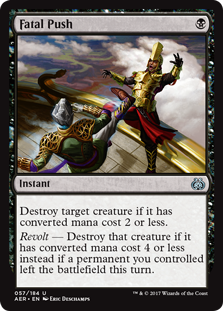
So of course the printing of Fatal Push remodeled the Modern landscape. Let's compare MTGGoldfish's 50 most-played creatures today to their Top 50 list from May 2016, when I wrote "What's in a Goyf?"
As a reliable one-mana kill spell, Push certainly beats Lightning Bolt, hitting a whopping 86% of the list vs. Bolt's 76% coverage from a year ago. These days, Bolt shoots a statistically similar 78%, so the card isn't worse in a vacuum; it's just been joined by a younger, more specialized partner. Push skirts on Bolt's utility dimensions of interacting with planeswalkers or closing out games, but outperforms Bolt as removal, leading some decks to prefer it, or at least not to splash red (the more flexible card of the two, Bolt still leads Push by 9% in terms of overall representation).
Based on these Goldfish charts and the metagame dynamism we've observed since Aether Revolt, Push's introduction seems to have modified the bar for Modern creature playability in two significant ways:
- More three-drops that die to Bolt have become playable (Spell Queller; Tireless Tracker; Thalia, Guardian of Thraben; Goblin Rabblemaster).
- Two-drops that don't die to Bolt have become worse (Tarmogoyf; Thing in the Ice // Awoken Horror; Spellskite; Wall of Roots).
 Overall, Push's presence increases diversity among playable Modern creatures. The new three-drops that are soft to Bolt outnumber the tried-and-true, Bolt-resistant two-drops that now lose value.
Overall, Push's presence increases diversity among playable Modern creatures. The new three-drops that are soft to Bolt outnumber the tried-and-true, Bolt-resistant two-drops that now lose value.
But there weren't many such two-drops in the format to begin with—the scarcity of these creatures made them indispensable in pre-Push Modern. Tarmogoyf, their poster-boy, has almost always been the format's most-played creature. Today, the Lhurgoyf clocks in as the 15th most-played creature. What happened, exactly?
Tarmogoyf: A Retrospect
To understand Goyf's future, we must understand Goyf's past. I've identified five chief draws to Tarmogoyf in pre-Push Modern, all of which contributed to its iron rule. Before Fatal Push, Tarmogoyf:
- Excelled on offense. Goyf provided more aggression for his cost than any other creature in Modern, and it wasn't close. Even decks with virtually no aggro plan sometimes splashed Tarmogoyf for a reliable way to attack opponents from a new angle.
- Excelled on defense. The green giant also did a fine job of locking down the battlefield—nothing deters opponents from attacking like a huge body. In terms of board presence, a permissible answer to Tarmogoyf was another Tarmogoyf, leading to "Goyf stalls" eventually broken by Bolts or Hierarchs.
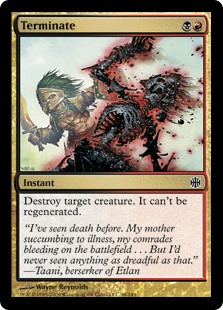 Sapped mana from opponents. No mana-positive method to remove Tarmogoyf existed. The exception: Path to Exile, which due to ramping the Goyf player was often inferior to parity-costed options like Exterminate! and Abrupt Decay. Both of which, mind you, are much tougher to splash. Spell Snare and even Flame Slash enjoyed widespread play for their coveted ability to do in a small window what Fatal Push now does in a wide one: trade with Goyf at a mana gain.
Sapped mana from opponents. No mana-positive method to remove Tarmogoyf existed. The exception: Path to Exile, which due to ramping the Goyf player was often inferior to parity-costed options like Exterminate! and Abrupt Decay. Both of which, mind you, are much tougher to splash. Spell Snare and even Flame Slash enjoyed widespread play for their coveted ability to do in a small window what Fatal Push now does in a wide one: trade with Goyf at a mana gain.
- Sapped cards from opponents. Decks not in white, BG, or BR had no way to effectively remove Goyf at all. Available solutions ranged from Engineered Explosives to Threads of Disloyalty, which all came at a mana loss and proved too narrow for mainboard inclusion. But tempo aside, these decks were often forced to spend two removal spells (often Lightning Bolts) on a single Goyf, rendering the creature a makeshift card advantage spell in many matchups.
- Punished opponents for interacting. Naturally, Goyf also rewarded its pilots for interacting, as shown by its tenure in BGx Rock. But this unique punishment aspect even earned the threat some play in linear decks. Whether the fatty buried Birds of Paradise or Glistener Elf, there was no funeral procession like a Tarmogoyf. And who wants to Thoughtseize away a card that actually advances your combo plan when you'd just respond by slamming a one-card win condition?
Who Played It?
I don't want to say everybody, but... well, everybody. Pre-Push, Tarmogoyf was a fixture in the aggro-control decks that policed Modern's linear decks, even finding its way into UR Twin in the form of Patrick Dickmann's groundbreaking Tempo Twin. Goyf was no total stranger to linear or combo strategies, either. Any of them in the market for Goyf's benefits would occasionally shrug and splash the beater themselves, among them Affinity, Infect, Scapeshift, and Birthing Pod.
Your Four Goyfs: Where Are They Now?
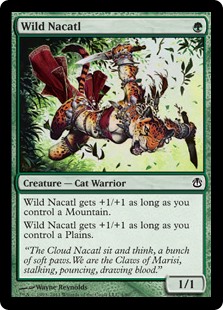 With Aether Revolt, everything changed. No longer would Goyf glacialize the battlefield or threaten to steal the game unless opponents sacrificed tempo and cards to remove it. Fatal Push answers Tarmogoyf more unequivocally than any Modern spell ever has (including surgical anti-Goyf tech like Deathmark and Self-Inflicted Wound).
With Aether Revolt, everything changed. No longer would Goyf glacialize the battlefield or threaten to steal the game unless opponents sacrificed tempo and cards to remove it. Fatal Push answers Tarmogoyf more unequivocally than any Modern spell ever has (including surgical anti-Goyf tech like Deathmark and Self-Inflicted Wound).
Tarmogoyf remains playable, but it's no longer insane. Think of it as "Wild Nacatl-Plus." Even though Modern now boasts a reasonable answer, Goyf still offers a whole lot of power and toughness for the cost; regardless of which player is attacking, it's likely to command respect on the ground.
Goyfing Today: A Crash Course
Not all decks run Fatal Push, and Tarmogoyf is just as good against the nonblack decks as ever. But facts are facts: Push has single-handedly caused Goyf's shares to plummet, and this era's successful Goyf decks all do one (or more) of three things to hedge against the instant.
This section touches on each of these methods while exploring how non-Goyf decks leverage the same principles.
Method 1: Overload Opposing Answers
Naya Company, by Casper Schaefer (11th, SCG Charlotte)
Opponents can't Push your Goyf if they've spent it on something else. Aggressive one-drops and mana dorks are ideal in the role of drawing fire away from Tarmogoyf, since they trade evenly with Push on mana. But must-answer two-drops work in a pinch. BGx Rock can sequence Tarmogoyf, Dark Confidant, and Grim Flayer in an order that sticks the best of the bunch.
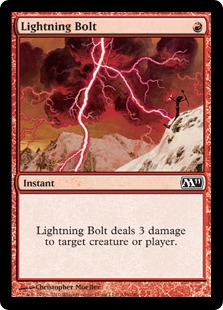 In the comments of my June article on Counter-Cat, some readers disagreed with my assessment of Wild Nacatl as a Push magnet, saying opponents would have just Bolted the Cat before Aether Revolt and never had an answer to Goyf. I think this view ignores the shifts decks have made to accommodate Fatal Push. Push replaces copies of Lightning Bolt and Exterminate! in the decks that ran those, so pairing Goyf with one-drops incentivizes opponents to burn their heavy-duty removal early. They'll have less lightweight removal for little threats at all, as Push cuts into those numbers.
In the comments of my June article on Counter-Cat, some readers disagreed with my assessment of Wild Nacatl as a Push magnet, saying opponents would have just Bolted the Cat before Aether Revolt and never had an answer to Goyf. I think this view ignores the shifts decks have made to accommodate Fatal Push. Push replaces copies of Lightning Bolt and Exterminate! in the decks that ran those, so pairing Goyf with one-drops incentivizes opponents to burn their heavy-duty removal early. They'll have less lightweight removal for little threats at all, as Push cuts into those numbers.
Example decks: Zoo, Company, BGx Rock
Relation to non-Goyf decks: The most obvious deck currently overloading removal spells is Humans, the breakout fish deck from SCG Cincinnati that went undefeated in that tournament before winning the Washington Classic a week later. No matter how much coverage spot removal spells have, threat-heavy decks like these will always barrel through a copy or two. In a way, stronger removal enables these archetypes. By axing narrower role-players like Lightning Bolt and Exterminate! for a compact suite of reliable Fatal Pushes, defensive decks lose an edge in swarmier matchups, where they'd rather have a critical mass of removal.
Method 2: Proactively Strip Opposing Answers
Jund, by Tyler Lutes (3rd, SCG Louisville)
Plucking removal spells from an opponent's hand before casting Tarmogoyf has always performed well in Modern, and the line is more relevant now than ever. Outside of targeted discard, attrition engines like Liliana of the Veil, Smallpox, and Lingering Souls also proactively pressure opponents to dump their Fatal Push.
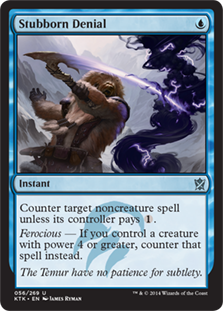 Why the focus on proactive disruption? Reactive answers lose out to discard because Modern lacks efficient permission. We don't want to trade a two-mana Mana Leak for a one-mana removal spell. The only blue instant we've seen fill this role is Stubborn Denial, a card less reliable and splashable, and one that crucially costs just one mana.
Why the focus on proactive disruption? Reactive answers lose out to discard because Modern lacks efficient permission. We don't want to trade a two-mana Mana Leak for a one-mana removal spell. The only blue instant we've seen fill this role is Stubborn Denial, a card less reliable and splashable, and one that crucially costs just one mana.
Example decks: BGx Rock, BGx Shadow
Relation to non-Goyf decks: Shadow employs this method to protect their namesake threat—while it admittedly trades with Push at mana parity, Death's Shadow still requires a hefty gameplay investment. Eldrazi Tron also utilizes the strategy. Four-drops are inherently riskier against Fatal Push than three-drops, since they cost more mana but ask opponents to fulfill the same conditions to snipe them. Thought-Knot Seer carries Eldrazi decks for the reason that it protects itself by casting Thoughtseize. Last but not least, Humans applies strip-and-commit with Kitesail Freebooter.
Method 3: Ask Better Questions
5-Color Shadow, by Clay Spicklemire (6th, SCG Louisville)
Playing a boatload of creatures? No thanks. Tempo-negative discard spells? Eh. Incidentally maximizing the potency of my favorite creature? Now here's a Push-proofing method I can get behind! While Clay's deck heavily flexes Method #2, 5-Color Shadow approaches the Push problem from another angle: it breeds 6/7 Tarmogoyfs.
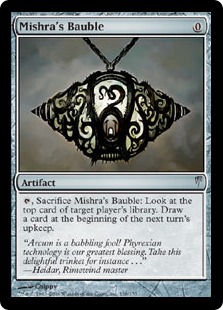 Spell Snare only trades with Goyfs on the stack, while Fatal Push kills them any time after resolution. Still, one Goyf the size of two Goyfs gives opponents half as much time to find that Fatal Push. And even if opponents have the Push, so what? These Goyfs are so great they're worth a lost mana here and there, and their sheer bulk scoops up points ceded to the instant in matchups where bulk matters dearly, like Eldrazi Tron.
Spell Snare only trades with Goyfs on the stack, while Fatal Push kills them any time after resolution. Still, one Goyf the size of two Goyfs gives opponents half as much time to find that Fatal Push. And even if opponents have the Push, so what? These Goyfs are so great they're worth a lost mana here and there, and their sheer bulk scoops up points ceded to the instant in matchups where bulk matters dearly, like Eldrazi Tron.
BGx Rock decks all run plenty of copies of Liliana of the Veil, but the fun doesn't stop there for Shadowless Goyf decks. Nihil Spellbomb, Seal of Fire, Mishra's Bauble, and other rare-type spells have seen varying play in rock decks, allowing them to capitalize on Method #3.
Example decks: BGx Rock, BGx Shadow
Relation to non-Goyf decks: While building around Goyf's literal text box is the least popular way to enable it, this method aligns most closely with Modern's identity. Infect, Dredge, Affinity, Burn, Counters Company, Elves, Tron... these top performers prize synergy over raw power, favoring cards that advance their linear gameplans to tried-and-true goodstuff staples.
Tarmo-Boyf
Combat adeptness; unparalleled splashability; large spikes. So long as these constants remain, I don't see Modern ever divorcing this hunky beater. Even as the world's #1 Tarmogoyf fan, I'm happy with how Push affects the format, and the first to admit that Goyf was a tad overpowered before the instant's arrival. Here's hoping Wizards continues to print efficient, generic answers à la Fatal Push that help Modern internally regulate its strongest cards, and that the format remains extremely diverse. In the meantime, may your green guys triumph!


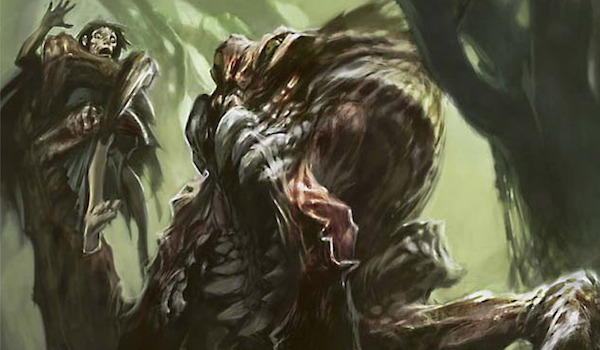


Thanks for this!
…an entire article which basically said that you play goyf in this meta the same way as the last one:
Overload threats, make him a creature they have to answer or die, or pack hand disruption.
Cool.
Goyf was once highly splashable in Modern; now he’s not. This article explains the conditions that must be met to run Goyf today.